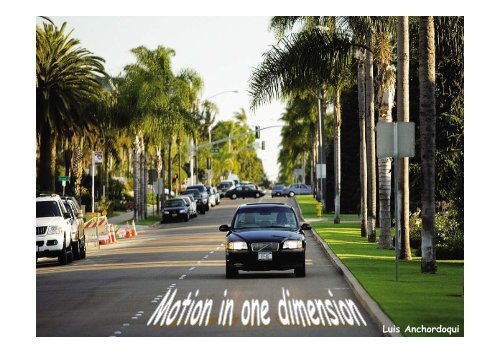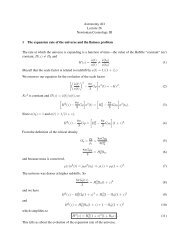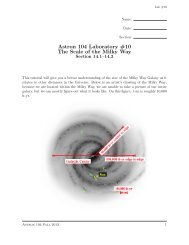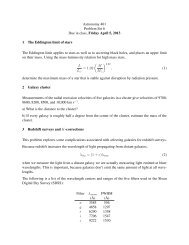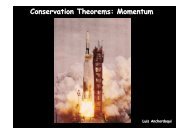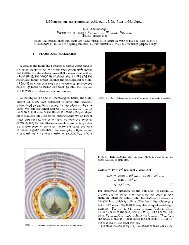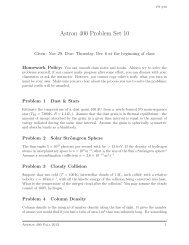Luis Anchordoqui
Luis Anchordoqui
Luis Anchordoqui
- No tags were found...
Create successful ePaper yourself
Turn your PDF publications into a flip-book with our unique Google optimized e-Paper software.
<strong>Luis</strong> <strong>Anchordoqui</strong>
Point particle• In a horse race the winner is the horse whose nose first crosses thefinish line• One could argue that what really matters during the race is themotion of that single point of the horse• In physics this type of simplification turns out to be useful forexamining the motion of idealized objects called point particles<strong>Luis</strong> <strong>Anchordoqui</strong>
Position and DisplacementTo describe the motion of a particle we need to be able todescribe the position of the particle and how that positionchanges as it movesThe change in the bicycle´s position is called a displacement<strong>Luis</strong> <strong>Anchordoqui</strong>
Distance and displacement of a dogYou are playing a game of catch with a dog.The dog is initially standing near your feet.Then he jogs 20 feet in a straight line to retrive a stick, and carriesthe stick 15 feet back towards you to chew the stick.(a) What is the total distance the dog travels?35 ft(b) What is the displacement of the dog?5 ft(c) Show that the net displacement for the trip is the sum of thesequential displacements<strong>Luis</strong> <strong>Anchordoqui</strong>
Average Velocity and SpeedAverage speed =Total distance traveled by the particleTotal time from start to finishAverage Velocity<strong>Luis</strong> <strong>Anchordoqui</strong>
Average speed and velocity of the dogThe dog that you were playing catch with jogged 20 ft away from youin 1s to retrieve the stick and ambled back 15 ft in 1.5 s.Calculate(a) the dog's average speed14 ft/s(b) the dog's average velocity for the total trip2 ft/s<strong>Luis</strong> <strong>Anchordoqui</strong>
Instantaneous VelocityThe instantaneous velocity is the limit of the ratio ∆x / ∆t as ∆tapproaches zeroslope of the line tangent to the x-versus-t curve<strong>Luis</strong> <strong>Anchordoqui</strong>
Instantaneous velocity (cont'd)◊ In calculus the limit that defines the instantaneous velocity is calledderivative of x with respect t◊ A line's slope may be positive, negative, or zero instantaneous velocity in 1dimension may be positive (x increasing), negative (x decreasing), or zero (no motion)◊ For an object moving with constant velocity the object's instantaneousvelocity is equal to its average velocity◊ The position versus time of this motion will be a straight lineThe instantaneous velocity is a vector and the magnitude of the instantaneousvelocity is the instantaneous speed* From now on: velocity to denotes instantaneous velocityand speed to denote instantaneous speed *<strong>Luis</strong> <strong>Anchordoqui</strong>
Position of a particle as a function of timeThe figure shows the position of a particle as a function of timeFind the instantaneous velocity at t= 1.8 s?v = slope ~ (8.5 m - 4.0 m)/ (5.0 s - 2.0 s) = 1.5 m/sxWhen the velocity is greatest?The tangent line is steepest and hence the velocity is greatest at t~4 sWhen is it zero?The velocity is zero at t=0 s and t=6 sIs it ever negative?The velocity is negative for t6 s<strong>Luis</strong> <strong>Anchordoqui</strong>
A stone dropped from a cliffThe position of a stone dropped from a cliff is describedapproximately by x = 5 t².The x-direction is downwards and the origin is at the topof the cliff.Find the velocity of the stone as a function of time.<strong>Luis</strong> <strong>Anchordoqui</strong>
AccelerationAccelaration is the rate of change of velocity with respect to timeAverage accelerationInstantaneous acceleration
A fast catThe cheetah can accelerate from 0 to 96 km/h in 2 s, whereas aCorvette requires 4.5 s.Compute the average acceleration for the cheetah and Corvetteand compare them with free fall acceleration.cat acceleration = 13 m/s² = 1.4 gcar acceleration = 5.9 m/s² = 0.6 g<strong>Luis</strong> <strong>Anchordoqui</strong>
Motion with constant accelerationx (t) = x + v t + 1/2 a t²v (t) = v + a t0 0Motion diagrams: moving object is drawn at equally space time intervals(a) The velocity is increasing so the acceleration is in the directionof the velocity vector(b) The velocity vector is decreasing so the acceleration is in thedirection opposite to that of the velocity vector<strong>Luis</strong> <strong>Anchordoqui</strong>
A Car's Stopping DistanceOn a highway at night you see a stalled vehicle and brake your car to stop.As you brake the velocity of your car decreases at a constant rate of 5 m/s².What is the car stopping distance if your initial velocity is 34 mi/h∆ x = 23 m<strong>Luis</strong> <strong>Anchordoqui</strong>
A Car's Stopping Distance (cont´d)How much times does it take for a car to stop if its initial velocity is 30 m/s∆t = 6 s<strong>Luis</strong> <strong>Anchordoqui</strong>
A Car's Stoping distance (cont'd)How far can the car travel in the last secondAverage distance = 2.5 m<strong>Luis</strong> <strong>Anchordoqui</strong>
A traveling electron (cont'd)An electron in a cathode-ray tube accelerates from rest with aconstant acceleration of 5.33 x 10¹²m/s² for 0.150 microseconds.The electron then drift with constant velocity for 0.200 microseconds.Finally it slows to stop with an acceleration of -2.67 x 10¹³m/s².How far the electron travel?x = 23.2 cm3<strong>Luis</strong> <strong>Anchordoqui</strong>
Estimate how long it took King Kong to fall straight down from theEmpire State Building (380 m high) and his velocity just before "landing."t ~ 8.8 sv ~ 86 m/sf<strong>Luis</strong> <strong>Anchordoqui</strong>
The Flying CapUpon graduation, a joyful physics student throw her capstraight upward with an initial speed of 14 m/s.<strong>Luis</strong> <strong>Anchordoqui</strong>
The Flying Cap (cont´d)Plot the position as a function of time and the velocity as a function of timeNote that the slope is equal to the instantaneous acceleration = 9.8 m/s²<strong>Luis</strong> <strong>Anchordoqui</strong>
Flying FlyingCap Capon onthe theMoonMoonThe acceleration due to gravity on the Moon is about one sixth what itis on the Earth. If the cap is thrown vertically upward on the Moon,how many times higher will it go than it would on Earth, assuming thesame initial velocity.The displacement increases by a factor of 6<strong>Luis</strong> <strong>Anchordoqui</strong>
Catching a Speeding CarA car is speeding at constant 56 mi/h in a school zone. A police car startsfrom rest just as the speeder passes by it and accelerates at constantrate of 5 m/s².(a)When does the police car catch the speeding car?(b) How fast is the police car traveling when it catches up with the speeder?(a) catching time = 10 s(b) police velocity = 50 m/s<strong>Luis</strong> <strong>Anchordoqui</strong>
Catching a Speeding Car (cont´d)How fast is the police traveling when is 25 m behind the speeding g carpolice velocity = 5.64 m/s and 44.4 m/s<strong>Luis</strong> <strong>Anchordoqui</strong>
007 is standing on a bridge, 12 m above the road below, and his pursuers aregetting too close for comfort. He spots a flatbed truck approaching at 25 m/s,which he measures by knowing that the telephone poles the truck is passing are25 m apart in this country. The bed of the truck is 1.5 m above the road, andBond quickly calculates how many poles away the truck should be when hejumps down from the bridge onto the truck to make his getaway.How many poles is it?Assume Bond's initial velocity is zero.He should jump when the truck is about 1.5 poles from the bridge<strong>Luis</strong> <strong>Anchordoqui</strong>
Deriving the Constant-Acceleration Kinematic EquationsTo obtain an equation for the position x as a function of time we firstlook at the special case of motion with constant velocity v = vx 0The change in position ∆ x during an interval of time ∆ t is ∆ x = v ∆ t0The area of the shaded rectangle under the v -versus-t curve isthe height vxxtimes its width ∆ tthe area under the curve is the displacement ∆x
Deriving the Constant-Acceleration Kinematic Equations (cont'd)The geometric interpretation of the displacement as the area under the v -versus-t curve is truexnot only for constant velocity, but it is true in general as illustrated in the figureTo show that this statement is true we first divide the time interval intonumerous small intervals ∆t , ∆t , and so on ...1 2The area of the rectangle corresponding to the ith interval ∆t i (shaded in the figure)is v i ∆t i ~ ∆x iThe sum of the rectangular areas is therefore approximately the sum of thedisplacements during the time intervalThe limit of the sum as ∆t approaches to zero is called the integral
Deriving the Constant-Acceleration Kinematic Equations (cont'd)ExampleFor a motion with constant acceleration ∆ x is equal to the area of theshaded region ∆ x = v ∆ t + a ∆ t²/21 x
A Coasting BoatA Shelter Island ferryboat moves with constant velocity v = 8 m/s forT = 60s. It then shuts off its engines and coasts.Its coasting velocity is given by v = v T²/t².What is the displacement of the boat for the interval 0 < t< infinity?x00∆ x = 960 m<strong>Luis</strong> <strong>Anchordoqui</strong>
Homework 1Which of the position-versus-time curves in the figure best showsthe motion of an object(a) with positive acceleration(b) with constant positive velocity(c) that is always at rest(d) with negative acceleration<strong>Luis</strong> <strong>Anchordoqui</strong>
Homework 2Which of the velocity-versus-time curves in the figurebest describes the motion of an object(a) with constant positive acceleration(b) with positive acceleration that is decreasing with time(c) with positive acceleration that is increasing with time(d) with no acceleration<strong>Luis</strong> <strong>Anchordoqui</strong>
Thanks&questions


